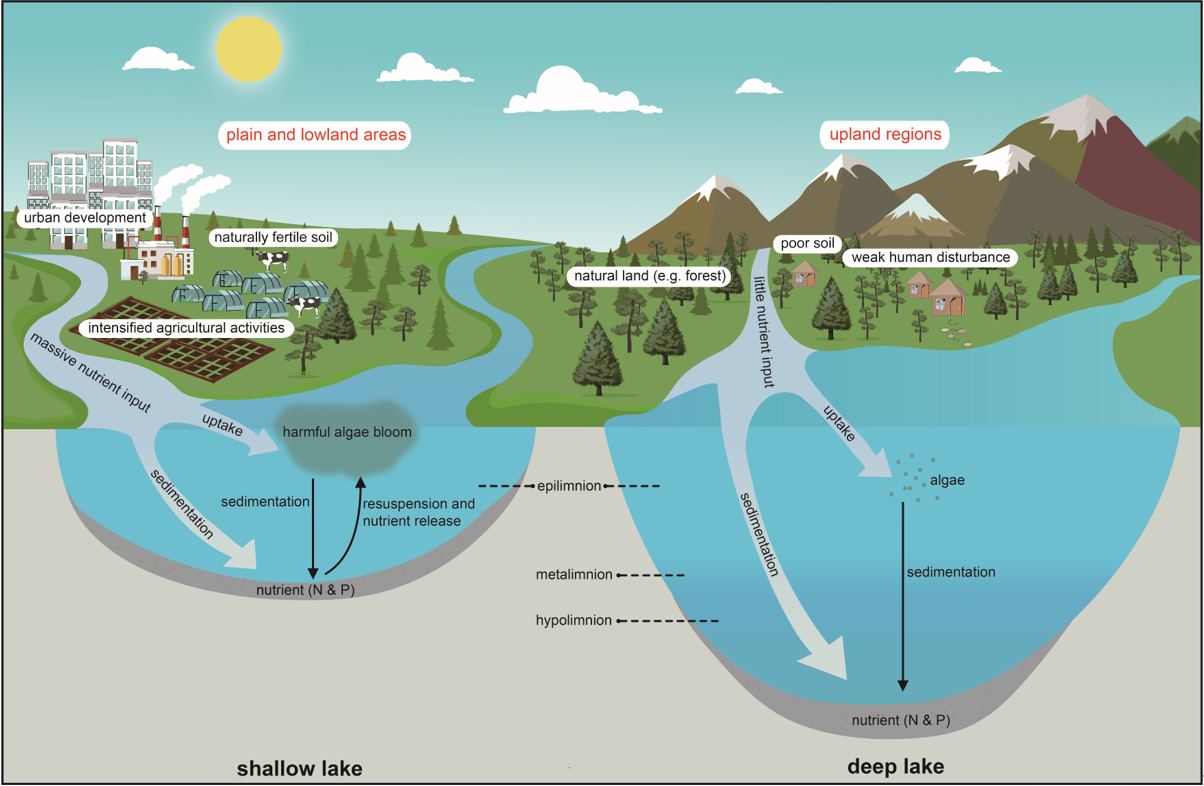Anthropogenic eutrophication of shallow lakes: Is it occasional?
According to the report of ‘The Fifth Global Environment Outlook’ by the United Nations Environment Program, more than 40% of water bodies all over the world are suffering eutrophication. Lake eutrophication is a great international concern because of its economic and ecological consequences.
Anthropogenic eutrophication of lake ecosystems is a widely acknowledged, but largely unresolved, especially for some large shallow lakes (Okeechobee, Winnipeg, Erie, Great Salt, and Champlain in North America, Lough Neagh, Peipsi, and Malaren in Europe, and Taihu, Chaohu, and Dianchi in China). It is worth thinking about why shallow lakes appear to be prone to eutrophication and resistant to restoration.
It is well recognized that the prevalence of lake eutrophication varies with respect to watershed geology, climate, land use, landscape position, connectivity, and lake morphology, each of which varies with lake district or ecoregion. However, most researches studied their effects on lake eutrophication separately, and relatively little is known of how these factors interact. A holistic understanding of lake eutrophication and improved lake management strategies requires freshwaters to be considered as part of an integrated socio-ecological system. There is a profound need to better understand the susceptibility of lakes to eutrophication to safeguard these systems for a sustainable future.
To protect lake ecosystems and achieve the Sustainable Development Goals identified by the United Nations, a group of Chinese scientists led by Prof. Boqiang Qin from the Nanjing Institute of Geography and Limnology, Chinese Academy of Sciences analyzed 1151 lakes with area ≥ 0.5 km2 located within the Europe and the United States of America to identify how lake morphology and regional social-ecological systems interact to affect the susceptibility of lakes to anthropogenic eutrophication.
Their findings were published in Water Research.
The findings demonstrate that lake depth is linked to the ecoregion and land use of lake ecosystems, which largely determines the intensity of human activities and, consequently, lake productivity. Specifically, lakes distributed in agricultural plain and densely populated lowland areas were generally shallow and subjected to intense human activities with high external nutrient inputs. In contrast, deep lakes frequently occurred in upland regions, dominated by natural landscapes with little anthropogenic nutrient input. Moreover, lake depth appeared to not only reflect external nutrient load to the lake, but also acted as an amplifier that increased shallow lake sensitivity to anthropogenic disturbance.
The susceptibility of lake to anthropogenic eutrophication, and consequently the risk of water quality issues, is not the same for all lakes. The findings suggest that shallow lakes are more susceptible to human forcing and are predisposed to receiving large quantities of nutrients, their eutrophication may be not an occasional occurrence. Special attention should be given to shallow lakes that are at high risk of waters quality degradation and eutrophication, yet may be more resistant to restoration compared to deep lakes.
In the future, increased agricultural production to meet demands for food and energy will intensify both point and diffuse sources nutrients. Many shallow lakes already exhibit eutrophic conditions, yet lie in watersheds where further eutrophication may be an inevitable rather than an occasional occurrence.
This information may help clarify why shallow lakes are prone to eutrophication and why some efforts to control eutrophication have resulted in frustratingly slow or modest effects in shallow productive lakes. This study helps set realistic goals and adjusts community expectations to advance the protection and restoration of lakes globally. It may be a challenge that convincing stakeholders continue to invest in nutrient reductions without evidence of rapid improvement, but it is necessary for long-term water quality improvement. The findings are expected to increase understanding for limnologists, stakeholders, and managers.

Lake depth relates the effects of external nutrient input and in-lake biogeochemical processes to regulate the productivity of lake ecosystems.
Generally, shallow lakes lie in naturally fertile plain and lowland regions, where they are exposed to strong anthropogenic disturbances (agriculture and urban development) and are predisposed to receiving large quantities of nutrients due to extensive drainage networks. In contrast, deep lakes are frequently concentrated in poor upland regions (mountains and highlands) with mainly natural land cover (e.g., forest and shrubland), low degrees of human disturbance, and limited nutrient input. Compared to deep lakes, shallow basins often have a small volume and weak capacity to dilute input nutrients resulting in high sensitivity to anthropogenic forcing. In addition, strong water-sediment interactions are more common and sediment is more prone to resuspension in shallow lakes, leading to elevated internal nutrient loading and higher productivity. Collectively, shallow lakes in agricultural or populated regions may be particularly susceptible to eutrophication and their eutrophication may be not an occasional occurrence.
Paper link: https://www.sciencedirect.com/science/article/pii/S0043135422006819
